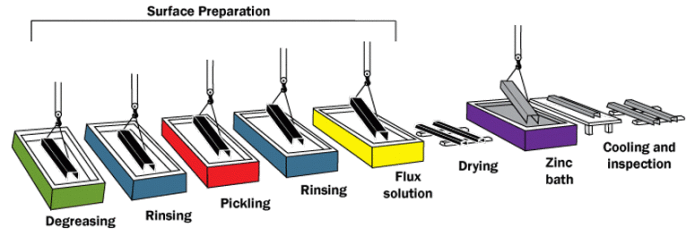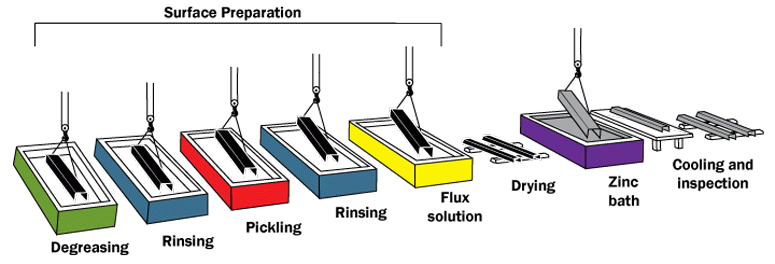The process of application of protective zinc coating to iron or steel in order to prevent them from rusting is called galvanization. Hot dip galvanizing is the most common method of galvanizing. This process includes the submergence of iron or steel in a molten zinc bath. Galvanization by forming a coating of zinc on the metals prevents any corrosive substance from reaching it.
A brief history of galvanization
Europeans were the first who encountered galvanization of iron on Indian armor, it can be found in the Royal Armories museum collection. Galvanization originally was associated with conduction of electric shocks, which was also called Faradism in the 19th century. The term, later, came to be associated with coating of zinc. A form of galvanization is known as hot dip galvanization. This process acts as a barrier between the atmosphere and steel and even if the galvanized coating gets damaged and steel gets exposed to the atmosphere, the zinc with the help of galvanic corrosion protects the steel.
What is Hot Dip Galvanization? – Read more
A brief about the process
A metallurgical bond is formed between zinc and steel by the process of hot dip galvanizing. A caustic solution is used to clean the steel from oil, grease, paint or dust. After rinsing off the caustic cleaning solution an acidic solution is used, which helps to remove mill scale. Then, a flux is applied, which most of the time contains zinc and ammonium chloride, which prevents oxidation of the cleaned surface to exposed air, the flux is then allowed to dry on the steel. After that, a molten zinc bath is used to submerge the zinc and left until the steel’s temperature equilibrates with the bath. Finally, a quench tank is used to cool down the steel. Adding a little lead to the zinc bath improves fluidity of the bath.
Hot Dip Galvanizing Process – read more
Benefits of Hot Dip Galvanizing & its impact on longevity of metal
Other commonly specified steel coatings are much more expensive than this process. Even if the cost of the initial coating in cases are higher than other coating, but in the long term this process is the cheapest. Because it has a good longevity and needs very less maintenance cost. It might cause some maintenance problem in case the structure is located in a remote area, however it lasts more than 50 years. It gives complete protection. A reliable hot dip galvanizer knows how to prevent a steel from rusting with the process of hot dip galvanizing.
Steel although a fascinating material can be corroded by the elements and air pollution, this hot dip galvanized procedure not only protects the steel in an economic way but also in an environmentally friendly manner. Without this protection steel is bound to rust when exposed to atmospheric condition over time. There are protective methods like plastic coating and painting, but these methods have numerous drawbacks. Hot dip galvanized procedure is not only reliable but also last very long. If you feel that your project requires special care, you must definitely go to an efficient hot dip galvanized service provider. Hot dip galvanizing in Vadodara is really reliable and long lasting service available in Vadodara.
Visit: www.galvanizers.co.in for more or Call us: +91 80008 42648




